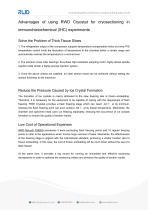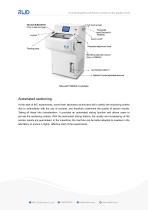 Website:
RWD Life Science
Website:
RWD Life Science
RWD Application of Cryostat as the Histology Equipment in Immunohistochemical Experiments
1 /
3Pages
Catalog excerpts

Application of Cryostat as the Histology Equipment in Immunohistochemical Experiments Steps for the Preparation of Sections in Immunohistochemical Experiments Histology equipment is essential in immunohistochemical (IHC) experiments. The 2 common types of sectioning methods employed in IHC experiments are paraffin sectioning and frozen sectioning. The steps of paraffin sectioning are: collection of a fresh specimen — dehydration (fixation, dehydration, clearing, wax infiltration) — paraffin embedding — slicing — staining, mounting — observation under the microscope; this process involves the use of basic histology equipment including the dehydrator, OCT compound, paraffin sectioning machine, staining machine, mounting machine, microscope and so on. The steps of frozen sectioning are: collection of a fresh specimen — frozen embedding — slicing — staining (can be done manually) — observation under the microscope. For this sectioning process, basic histology equipment includes flash freezer, frozen sectioning machine and microscope. Common Problems of Immunohistochemical (IHC) Experiments The requirements of IHC experiments depend on the types of specimens, antigens and sectioning methods. Meanwhile, the preparation of paraffin sections in IHC experiments involves complicated steps. The pre-treatment of tissues has high requirements as some antigens may be destroyed midway through the process, resulting in the step of antigen retrieval. The step of retrieval can be omitted in frozen sectioning as it does a better job in preserving the immunocompetence of antigens. If you want to skip the step of antigens retrieval–in which case, frozen sectioning will become the method of choice. However, it will easily lead to the formation of ice crystals, inflicting a certain level of damage on the cell structures. Besides, slices prepared by frozen sectioning are thicker than those prepared by paraffin sectioning, leading to a direct impact on the section results. If the chamber of the cryostat doesn’t provide sufficient refrigeration, then a flash freezer will be used for supporting the frozen embedding process. At the same time, one has to consider how to accommodate the needs of junior laboratory technicians in order to ensure that everything will run smoothly at the start of the experiment. In this case, the cost of operating expenses for the laboratory co
Open the catalog to page 1
Advantages of using RWD Cryostat for cryosectioning in immunohistochemical (IHC) experiments Solve the Problem of Thick Tissue Slices 1. The refrigeration output of the compressor supports temperature compensation twice at a time; PID temperature control limits the fluctuation of temperature in the chamber within a certain range and automatically restores the temperature to a normal level. 2. The premium cross roller bearings, five-phase high-resolution sampling motor, highly-dense spindle, injection slide render a highly-precise injection system. 3. Once the above criteria are satisfied,...
Open the catalog to page 2
Automated sectioning At the start of IHC experiments, some fresh laboratory technicians fail to satisfy the sectioning criteria due to unfamiliarity with the use of cryostat, and therefore undermine the quality of section results. Taking all these into consideration, it provides an automated slicing function and allows users to pre-set the sectioning criteria. With the automated slicing feature, the quality and consistency of the section results are guaranteed. In the meantime, the machine can be better adapted to newbies in the laboratory to ensure a highly- effective start of the...
Open the catalog to page 3All RWD Life Science catalogs and technical brochures
-
RWD Gradient Thermal Cycler
2 Pages
-
Rotary Microtomes S710
2 Pages
-
RWD Osmotic infusion Pump
2 Pages
-
RWD Syringe Pump R462
1 Pages
-
RWD Rotating impactor 68099Ⅱ
2 Pages
-
RWD Microcentrifuge M1324R
2 Pages
-
RWD Infusion imager RFLSI Ⅲ
2 Pages
-
RWD Surgical Instruments
18 Pages
-
RWD Veterinary medical equipment
32 Pages
-
RWD R415 Animal Ventilatorr
1 Pages
Archived catalogs
-
PRODUCT CATALOGUE 2017
51 Pages
-
2015 Product Catalogue
44 Pages


















































































